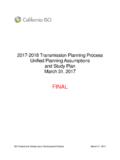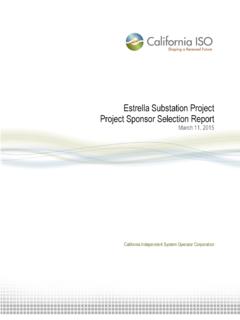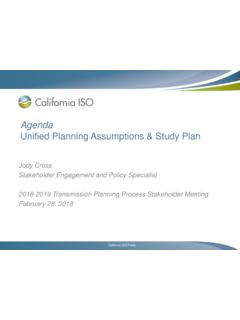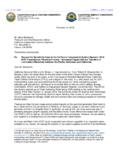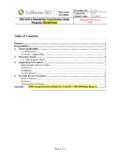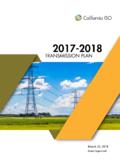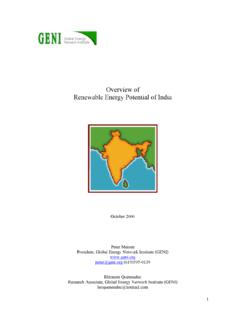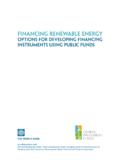Transcription of INTEGRATION OF RENEWABLE RESOURCES
1 INTEGRATION OFRENEWABLE RESOURCESrpsOperational Requirements and Generation Fleet Capability at 20% RPSA ugust 31, 2010 California ISO INTEGRATION of RENEWABLE RESOURCES at 20% RPS Table of Contents Preliminary Notes and Key to Figures .. i Acronyms and Selected Definitions .. ii Executive 1 Introduction .. 1 Report Organization .. 2 California RENEWABLE Portfolio Standards .. 3 Potential Impacts in System Operations .. 4 Variability of Wind and Solar Generation .. 5 Wind and Solar Forecast Uncertainty .. 12 Impact of Variability and Uncertainty on market and System Operations.
2 13 Overgeneration due to Variable Energy RESOURCES .. 17 Objectives of this Study .. 19 2 Study Methodology and Assumptions .. 21 Study Scenario Data and Assumptions .. 22 Load .. 22 RENEWABLE resource Portfolios by Capacity .. 24 Aggregate Energy Production by RENEWABLE RESOURCES .. 26 Development of Wind and Solar Production Profiles .. 26 Load Net of RENEWABLE Energy by Season in 2012 .. 27 Methodology for Determining Operational Requirements .. 29 Overview of the Operational Requirements Simulation Methodology .. 30 Determination of simulated load-following requirements.
3 32 Determination of simulated regulation requirements .. 33 Production Simulation Methodology for Evaluation of Fleet Capability .. 36 Data and Assumptions .. 37 Stochastic Sequential Production Simulation Methodology .. 44 3 Analysis of Operational Requirements .. 47 Summary of findings .. 49 Comparison of seasonal results .. 50 Load-following Requirements for Summer 2012 .. 52 Regulation Requirements for Summer 59 4 Analysis of Historical Fleet Capability .. 65 Summary of Findings .. 65 Physical Characteristics of the Existing Generation Fleet.
4 65 Load-following Capability .. 66 Regulation Capability .. 70 5 Analysis of Operational Capability under 20 percent RPS .. 75 Summary of Findings .. 75 Load-following and Regulation Impacts .. 75 Load-following Capability under Low Dispatchability Conditions .. 77 Load-following Capability under High Dispatchability Conditions .. 80 Quantification of Annual Load-following Shortages .. 83 Impact of Non-dispatchability on Overgeneration .. 84 Fleet Operations and Economic Impacts .. 86 6 Key Study Conclusions and Recommendations.
5 92 Appendix A Additional Operational Requirements Results ..A-1 Appendix B - Additional Fleet Capability Appendix C Additional Production Simulation Results ..C-1 California ISO INTEGRATION of RENEWABLE RESOURCES at 20% RPS Study Team GE Energy Consulting Sundar Venkataraman Gary Jordan Richard Piwko Lavelle Freeman California ISO Udi Helman Clyde Loutan Grant Rosenblum Mark Rothleder June Xie Hong Zhou Michael Kuo With advisory support from Professor Benjamin Hobbs California ISO market Surveillance Committee & The Johns Hopkins University Pacific Northwest National Laboratory Jian Ma Yuri Makarov PLEXOS Tao Guo Wenxiong Huang Eric Toolson Nexant Anupama Pandey Barney Speckman Paul Worhach California ISO INTEGRATION of
6 RENEWABLE RESOURCES at 20% RPS i Preliminary Notes and Key to Figures 1. A number of the technical terms in this report refer to market products and market scheduling or operational procedures used by the ISO. Typically, such references are capitalized in ISO papers and reports to indicate that they are a defined term in the ISO Tariff. In this report, most technical terms are not capitalized and the use of acronyms is minimized to facilitate reading. For example, Regulation Up and Regulation Down are ancillary service products procured in the ISO markets, but are not capitalized in the report.
7 2. Many of the figures in the report represent data in the format of a stock chart or whisker chart that shows certain distribution statistics for a sample of simulated values or actual market results, typically shown by hour of season. In the example below, the top of the red or blue lines is the maximum data point in a sample, while the bottom of the red or blue lines is the minimum data point. The red and blue bars represent two standard deviations: the average plus one (1) standard deviation and the average minus one (1) standard deviation.
8 Many of the figures, such as the one below, show these results for two simulated years that are being compared, in which case the results for each year are in different colors. 3. The figures in the report that use the format shown above are either measuring operational requirements in the upwards (positive) direction, which represent incremental energy or reserves, or in the downwards (negative) direction, which represents decremental energy or reserves. The figure above is for incremental energy, hence the vertical axis (or y-axis) is measuring positive values.
9 For figures that show decremental energy or reserves, the y-axis shows negative values and the maximum and minimum of the sample data is reversed ( , the maximum requirement is the most negative). 4. In several sections of the report, readers need to distinguish between simulated results and actual results for the same or similar years. For certain simulations, the study benchmarks the results in the 20 percent RPS target year, assumed to be 2012, by simulation of prior years without the additional renewables, which in this study is 2006 and 2007.
10 The study also includes analysis of actual ISO market and system conditions for selected periods up to 2010. The simulations of prior years, such as 2006, have been validated by comparison to actual conditions in those years, but there are differences due to modeling assumptions, as noted in the report. Hourly maximum values Hourly minimum values Average 1 Standard Deviation California ISO INTEGRATION of RENEWABLE RESOURCES at 20% RPS ii Acronyms and Selected Definitions ACE Area Control Error ADS Automatic Dispatch Signal AGC Automatic Generation Control BAA Balancing Authority Area BPM Business Practice Manual CEC California Energy Commission CPS Control Performance Standard CPUC California Public Utilities Commission DA Day Ahead EMS Energy Management System FERC Federal Energy Regulatory Commission FNM Full

